I would be skeptical of a torsion bar suspension in a tank. However, they had to have some way to get the tracks out of the way of the road wheels...Note the configuration of the road wheels in the Bovington Luchs. The front road (the wheels without teeth) is inside and the second road wheel is outside.
In the Falaise Luchs, the first road wheel is outside and the second road wheel is inside.
View attachment 4174
This makes me wonder whether the road wheels were reversible. They appear to be slightly concave and this vehicle has a tortion bar suspension, so maybe they were reversible.
75th anniversary of D-Day...
- Thread starter crimsonaudio
- Start date
- Status
- Not open for further replies.
The M1 has a torsion bar suspension. If you break one (it happens), boy is that a pain in the neck for the crew.I would be skeptical of a torsion bar suspension in a tank. However, they had to have some way to get the tracks out of the way of the road wheels...
I have replaced a torsion bar on an M113 armored personnel carrier. That ain't a walk in the park. You have to break track (no fun), take the road wheels off (on both sides because the road wheel on the other side covers the opening to the broken torsion bar). Then you have to bang the broken torsion bar out, replace it with a good torsion bar, reattach the road wheels, put the track back on.
Doing the same thing on an M1 is an order of magnitude more difficult.
Last edited:
with all the tracks in the pic, and look in front of that road wheel, is that black part a sprocket attachment point? Makes me wonder if someone was possibly trying to salvage parts or repair something broken?Note the configuration of the road wheels in the Bovington Luchs. The front road (the wheels without teeth) is inside and the second road wheel is outside.
In the Falaise Luchs, the first road wheel is outside and the second road wheel is inside.
View attachment 4174
This makes me wonder whether the road wheels were reversible. They appear to be slightly concave and this vehicle has a tortion bar suspension, so maybe they were reversible.
Maybe, but that is one heck of a time and place to do some intensive maintenance. With Allied artillery raining down and 9th Tactical Air Force jabos overhead looking for targets, I would not want to salvage a tank as useless as a Luchs/Pzkw Mark II.with all the tracks in the pic, and look in front of that road wheel, is that black part a sprocket attachment point? Makes me wonder if someone was possibly trying to salvage parts or repair something broken?
That would feel like fixing your Yugo in a tornado.
Last edited:
Ouch!The M1 has a tortion bar suspension. If you break one (it happens), boy is that a pain in the neck for the crew.
I have replaced a torsion bar on an M113 armored personnel carrier. That ain't a walk in the park. You have to break track (no fun), take the road wheels off (on both sides because the road wheel on the other side covers the opening to the broken tortion bar). Then you have to bang the broken tortion bar out, replace it with a good tortion bar, reattach the road wheels, put the track back on.
Doing the same thing on an M1 is an order of magnitude more difficult.
When I was at Benning for Basic, the motor sergeant issued a M113 track that had 30 "dead" track pads (i.e. worn out bushings on the pin that connects one track pad to the next track pad). To fix that, you have to break the track 30 times, and replace the "dead" pad each time, then put it back together.Ouch!
Rather than fix that track themselves, they issued the unserviceable vehicle to the neophytes (who were too inexperienced to notice). When the vehicle returned to the motor pool, the maintenance sergnts "discovered" that the track had 30 dead track pads.
"Well, boys, looks like you're going to spend the next three hours breaking track. It's good training."
August 20, 1944: The encirclement of the German forces is completed southeast of Falaise - the German troops and vehicles are forced to attempt to escape the pocket via a small corridor between Trun, Saint-Lambert and Chambois, which is constantly bombarded by the Allied aviation and artillery. The destruction of the forces in this corridor is indescribable: smoldering carcasses of vehicles, German bodies and dead horses (used for their evacuation) litter the roads and rivers, offering a terrifying view of an army in panic and disarray. Over 200 tanks, nearly 1,000 artillery guns and thousands of miscellaneous vehicles are destroyed.
Seeing the Allied forces focusing on the escaping Germans, two German formations (the 2nd and 9th SS-Panzer Divisions) attack Polish positions on Hill 262, the 16th Infantry and 12th SS Panzer divisions attack American and Canadian forces from within the pocket, opening small channels through Allied positions which allows more German forces to escape via bridges over the Dives river. By mid-morning, 2,000 survivors of the German 2nd Fallschirmjäger Korps have managed to breach Canadian positions along the Dives River, as well as at Point 117. At approximately noon, several units of the 10th SS, 12th SS and 116th Panzer Divisions managed to break through these weakened positions.
By mid afternoon, reinforcements from a Canadian armored battle group under Major David Vivian Currie manage to reach St. Lambert-sur-Dives, denying two German armies evacuation from the pocket. Over the next 36 hours, the battle group repulses almost continual attacks by German forces, destroying 7 German tanks, 12 88mm antitank guns and 40 vehicles. In the brutal fighting around Lambert-sur-Dives, Currie's battle group is able to inflict nearly 2,000 casualties on attacking German forces, including 300 killed and 1,100 captured. By nightfall, the Germans have exhausted their attack against St. Lambert-sur-Dives; the surviving members of the 84th Korps, commanded by General Elfeld, surrender to Canadian and American forces near Chambois. For his actions at St. Lambert-sur-Dives, Major Currie was awarded the Victoria Cross, the only Canadian so honored for service in the Normandy Campaign.
To the east of Caen, as part of Operation Paddle, the British commandos (supported by soldiers of the Piron Belgian Brigade) attack the villages of Dozulé and Brucourt. The Belgian brigade is at the gates of Cabourg, and has liberated Le Home on its way.
Above France, RAF 2nd Tactical Air Force conducting ground support missions, offensive sorties, and defensive patrols, including heavy attacks against the Falaise pocket. US 9th Air Force aircraft support advancing Allied ground troops.
On the eastern front, in Latvia, Soviet attacks continue. Naval support from the German heavy cruiser Prinz Eugen assists Army Group North in holding a Soviet advance near Riga. In the south, a large-scale artillery barrage during the night heralds a new Soviet attack, called the Jassy-Kishinev offensive. The 2nd Ukrainian Front (Malinovsky) advances south from Jassy, smashing Rumanian 4th Army, and the 3rd Ukrainian Front advances southwest from Tiraspol, attacking the German 6th Army and blasting a 30-mile gap in the front. The Romanian 3rd and 4th Armies, on the right and left flanks of German 6th Army are the initial targets of the assault.
In Italy, British 8th Army and US 5th Army continue regrouping for new offensive.
Pictured: ‘Corridor of Death’ littered with death and destruction of the German army, near Hill 262 (Mont Ormel), August 20, 1944; German counterattacks and breakthrough attempts repelled by the Canadians and Poles; Currie (left of center, holding a revolver) accepting the surrender of German troops at St. Lambert-sur-Dives, August 20, 1944; American troops posing with a captured Nazi flag and a wrecked German tank, Chambois, France, August 20, 1944


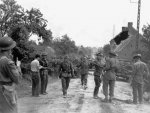
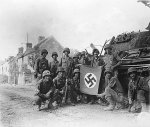
Seeing the Allied forces focusing on the escaping Germans, two German formations (the 2nd and 9th SS-Panzer Divisions) attack Polish positions on Hill 262, the 16th Infantry and 12th SS Panzer divisions attack American and Canadian forces from within the pocket, opening small channels through Allied positions which allows more German forces to escape via bridges over the Dives river. By mid-morning, 2,000 survivors of the German 2nd Fallschirmjäger Korps have managed to breach Canadian positions along the Dives River, as well as at Point 117. At approximately noon, several units of the 10th SS, 12th SS and 116th Panzer Divisions managed to break through these weakened positions.
By mid afternoon, reinforcements from a Canadian armored battle group under Major David Vivian Currie manage to reach St. Lambert-sur-Dives, denying two German armies evacuation from the pocket. Over the next 36 hours, the battle group repulses almost continual attacks by German forces, destroying 7 German tanks, 12 88mm antitank guns and 40 vehicles. In the brutal fighting around Lambert-sur-Dives, Currie's battle group is able to inflict nearly 2,000 casualties on attacking German forces, including 300 killed and 1,100 captured. By nightfall, the Germans have exhausted their attack against St. Lambert-sur-Dives; the surviving members of the 84th Korps, commanded by General Elfeld, surrender to Canadian and American forces near Chambois. For his actions at St. Lambert-sur-Dives, Major Currie was awarded the Victoria Cross, the only Canadian so honored for service in the Normandy Campaign.
To the east of Caen, as part of Operation Paddle, the British commandos (supported by soldiers of the Piron Belgian Brigade) attack the villages of Dozulé and Brucourt. The Belgian brigade is at the gates of Cabourg, and has liberated Le Home on its way.
Above France, RAF 2nd Tactical Air Force conducting ground support missions, offensive sorties, and defensive patrols, including heavy attacks against the Falaise pocket. US 9th Air Force aircraft support advancing Allied ground troops.
On the eastern front, in Latvia, Soviet attacks continue. Naval support from the German heavy cruiser Prinz Eugen assists Army Group North in holding a Soviet advance near Riga. In the south, a large-scale artillery barrage during the night heralds a new Soviet attack, called the Jassy-Kishinev offensive. The 2nd Ukrainian Front (Malinovsky) advances south from Jassy, smashing Rumanian 4th Army, and the 3rd Ukrainian Front advances southwest from Tiraspol, attacking the German 6th Army and blasting a 30-mile gap in the front. The Romanian 3rd and 4th Armies, on the right and left flanks of German 6th Army are the initial targets of the assault.
In Italy, British 8th Army and US 5th Army continue regrouping for new offensive.
Pictured: ‘Corridor of Death’ littered with death and destruction of the German army, near Hill 262 (Mont Ormel), August 20, 1944; German counterattacks and breakthrough attempts repelled by the Canadians and Poles; Currie (left of center, holding a revolver) accepting the surrender of German troops at St. Lambert-sur-Dives, August 20, 1944; American troops posing with a captured Nazi flag and a wrecked German tank, Chambois, France, August 20, 1944




An interesting video on what happened to some of the German Panthers abandoned in Normandy.
The French incorporated them into their army, during the war and even after.
The French incorporated them into their army, during the war and even after.
I think this is very important. It is one thing to look at lines on a map, and assume a pocket is sealed hermetically. Reality on the ground is sometimes very different. If you have a platoon of tanks at one point of that line and the next platoon is 2 miles away, is the pocket really sealed?August 20, 1944: German counterattacks and breakthrough attempts repelled by the Canadians and Poles; Currie (left of center, holding a revolver) accepting the surrender of German troops at St. Lambert-sur-Dives, August 20, 1944; American troops posing with a captured Nazi flag and a wrecked German tank, Chambois, France, August 20, 1944
View attachment 4178
And here is a view of the Dives "River." Here in Virginia we would call this a creek or a draft or run.
Yeah, i was looking on GE trying to find the "river"...I think this is very important. It is one thing to look at lines on a map, and assume a pocket is sealed hermetically. Reality on the ground is sometimes very different. If you have a platoon of tanks at one point of that line and the next platoon is 2 miles away, is the pocket really sealed?
And here is a view of the Dives "River." Here in Virginia we would call this a creek or a draft or run.
And it was exactly what Bradley and Ike feared would happen, if Patton were allowed to "seal" the mouth of the pocket prematurely...I think this is very important. It is one thing to look at lines on a map, and assume a pocket is sealed hermetically. Reality on the ground is sometimes very different. If you have a platoon of tanks at one point of that line and the next platoon is 2 miles away, is the pocket really sealed?
And here is a view of the Dives "River." Here in Virginia we would call this a creek or a draft or run.
Here is what is different about the "cauldron battle" of Falaise and those of the early German advances on the Eastern Front. The Germans would rip two holes in the Red Army front, and then send a Panzer Corps each like arms through the two holes and those two would link up at some point well in the rear of the Red Army front, as a point where there was no Red Army unit (or no known Red Army unit). When each unit got to the link-up point, they were expecting friendly troops , not enemy troops.And it was exactly what Bradley and Ike feared would happen, if Patton were allowed to "seal" the mouth of the pocket prematurely...
In the case of Falaise, the Allies had only one arm (Patton) and were linking up with the Canadians at the German front lines, so they knew there were enemy troops at the link-up site. And not just any unit, but SS Panzer units who were know to be better-equipped than Wehrmacht and tended to fight fanatically. This generated some caution on Bradley's part.
Last edited:
August 21, 1944: The escape of the German forces from the ‘Falaise pocket’ is now complete and many Germans have retreated to the east side of the Seine river. While more than 10,000 soldiers were killed and more than 40,000 captured, some 98,000 Germans remain to rebuild forces on the opposite bank of the Seine. This bad news for the Allies leads to a new plan: a siege on a larger scale is considered, which plans to trap the fleeing German soldiers heading towards the east of France (most of the 17th SS Panzer Grenadier Division already reached the Lorraine region the week before). The Canadians control the village of Saint-Lambert-sur-Dives. The Poles, who are positioned on Hill 262 overlooking the village of Chambois, are again attacked by elements of the 2nd Panzer Corps, but they manage to counter the assault.
The Americans continue making rapid progress to the east towards the Seine river, and cross bridges created by the engineers of the 157th Engineer Combat Battalion. The town of Mantes is reached during the day by the 15th Corps (led by Patton) and other units of the 3rd Army now head towards Fontainebleau, Melun and Sens. U.S. troops continue advancing much faster than the British and Canadians.
Model reports to Berlin that German 7th Army has been destroyed and Paris cannot be held.
Northeast of Caen, the British and Belgian troops continue their offensive: the town of Cabourg is liberated and the Piron’sBelgium Brigade occupies the village of Dives.
Both RAF 2nd Tactical Air Force and US 9th Air Force grounded by poor weather conditions.
On the eastern front the German 3rd Panzer Army, attacking toward Riga, opens corridor to 16th Army. Soviet 2nd Ukrainian Front captures Jassy, overruns more defensive positions, and pushes back Rumanian 4th Army and German 8th Army. Soviet 3rd Ukrainian Front continues its offensive, and German 6th Army begins to collapse.
In Italy, while US 5th Army and much of British 8th Army regroup for a new offensive, Polish II Corps of British 8th Army continues to attack around San Constanzo, and German forces withdraw behind Metauro River overnight.
Pictured: Knocked-out German StuG III assault gun and soft-skin vehicles shot up by Allied fighter-bombers, August 21, 1944; Wrecked German transport and knocked out tanks on a road in the Falaise-Argentan area, August 21, 1944; Polish armor holds SS counter-attack at Mont-Ormel Cromwell tanks of the 10th Mounted Rifles Regiment (1st Armored Division) use a hedge for cover during the Operation Totalise, August 21, 1944; Infantry from the 80th Division take a break in the ruins of Argentan
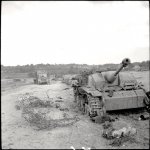
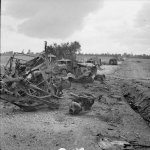
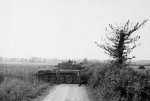
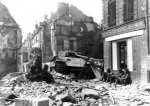
The Americans continue making rapid progress to the east towards the Seine river, and cross bridges created by the engineers of the 157th Engineer Combat Battalion. The town of Mantes is reached during the day by the 15th Corps (led by Patton) and other units of the 3rd Army now head towards Fontainebleau, Melun and Sens. U.S. troops continue advancing much faster than the British and Canadians.
Model reports to Berlin that German 7th Army has been destroyed and Paris cannot be held.
Northeast of Caen, the British and Belgian troops continue their offensive: the town of Cabourg is liberated and the Piron’sBelgium Brigade occupies the village of Dives.
Both RAF 2nd Tactical Air Force and US 9th Air Force grounded by poor weather conditions.
On the eastern front the German 3rd Panzer Army, attacking toward Riga, opens corridor to 16th Army. Soviet 2nd Ukrainian Front captures Jassy, overruns more defensive positions, and pushes back Rumanian 4th Army and German 8th Army. Soviet 3rd Ukrainian Front continues its offensive, and German 6th Army begins to collapse.
In Italy, while US 5th Army and much of British 8th Army regroup for a new offensive, Polish II Corps of British 8th Army continues to attack around San Constanzo, and German forces withdraw behind Metauro River overnight.
Pictured: Knocked-out German StuG III assault gun and soft-skin vehicles shot up by Allied fighter-bombers, August 21, 1944; Wrecked German transport and knocked out tanks on a road in the Falaise-Argentan area, August 21, 1944; Polish armor holds SS counter-attack at Mont-Ormel Cromwell tanks of the 10th Mounted Rifles Regiment (1st Armored Division) use a hedge for cover during the Operation Totalise, August 21, 1944; Infantry from the 80th Division take a break in the ruins of Argentan




The Allies had a second chance to trap those escaping German units by driving north along the Seine. While the Dives river is not a significant obstacle at Falaise, the Seine is.August 21, 1944: The escape of the German forces from the ‘Falaise pocket’ is now complete and many Germans have retreated to the east side of the Seine river. While more than 10,000 soldiers were killed and more than 40,000 captured, some 98,000 Germans remain to rebuild forces on the opposite bank of the Seine.
Here is a picture of the Seine at Rouen.

It is a modern bridge, but the size of the Seine shows how serious of an obstacle it would be.
Seizing the east bank of the Seine would make for a hermetical seal and trap all the German forces.
The problem is that the Seine is a winding river in that stretch.
Last edited:
I'll have to go back and check the subordinate corps and divisions, but I know that the 7th Army was regenerated. The 7th was given the task of securing the southern flank of the 5th Panzer Army in the Bulge (Wacht am Rhein).August 21, 1944: ... Model reports to Berlin that German 7th Army has been destroyed and Paris cannot be held.
Answered my own question. The 7th Army was rebuilt. In the Bulge it had the LIII Corps (formerly on the East Front), LXXX Corps and LXXXV Corps, none of which had been under the 7th Army in Normandy. The 352nd Infantry Division (reconstituted as the 352nd Volksgrenadier Division) and the 5th Parachute Division had been under the 7th Army in June and remained under the 7th Army by December. The rest of the 7th Army divisions in the Bulge were new to 7th Army.
Normandy had been a catastrophe for the Germans.
Last edited:
August 22, 1944: It’s Tuesday - today is D+77, marking 11 weeks since the D-Day Invasion at Normandy and the beginning of the liberation of Europe.
The civil uprising in the city of Paris continues and gains in intensity, so French General Leclerc (commander of the 2nd Armored Division) is ordered to progress to the French capital. The Americans of the 79th Infantry Division establish a beachhead beyond the Seine river in the Mantes region, pushing forward despite the attacks of the German 49th Infantry Division. The Germans, still trying to retreat on the other side of the Seine, are attacked by hundreds of American tanks between Vernon (liberated by the 79th Infantry) and Le Neubourg. Their flight is covered by the fervent fighting by the rearguard of the routed troops, which despite the dire situation for the Germans, slows the advance of the allied troops.
In the north-east of Caen, the Belgian brigade of Colonel Jean Piron, which supports the British 6th Airborne Division at the North, reaches Villers-sur-Mer after having liberated Cabourg the day before, and is also at the gates of Deauville. However, from here they to progress under the murderously heavy fire of the German batteries located on Mont Canisy, where the Germans had lined up eight batteries of four guns each.
On the eastern front, in the south, Soviet troops of 2nd Ukrainian Front capture Jassy in their southward advance. The 3rd Ukrainian Front expands its attacks in a northward direction, after having advance up to 50 miles in the past two days.
In Italy, Polish II Corps of British 8th Army pushes to south bank of Metauro River. US 12th Air Force aircraft attack bridges in northern Italy.
Pictured: Destroyed German Tiger II heavy tank near Vimoutiers, France, August 22, 1944; Aerial photograph of a Panther destroyed in the Chambois pocket, August 22, 1944; Situation map from Twelfth Army Group for August 22, 1944 (Select Options -> Download to view in hi-res); Polish resistance fighter with K pattern flamethrower, Warsaw, Poland, August 22, 1944
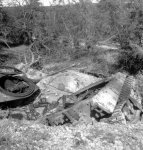
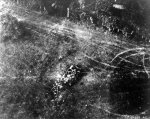
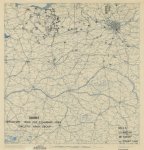
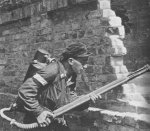
The civil uprising in the city of Paris continues and gains in intensity, so French General Leclerc (commander of the 2nd Armored Division) is ordered to progress to the French capital. The Americans of the 79th Infantry Division establish a beachhead beyond the Seine river in the Mantes region, pushing forward despite the attacks of the German 49th Infantry Division. The Germans, still trying to retreat on the other side of the Seine, are attacked by hundreds of American tanks between Vernon (liberated by the 79th Infantry) and Le Neubourg. Their flight is covered by the fervent fighting by the rearguard of the routed troops, which despite the dire situation for the Germans, slows the advance of the allied troops.
In the north-east of Caen, the Belgian brigade of Colonel Jean Piron, which supports the British 6th Airborne Division at the North, reaches Villers-sur-Mer after having liberated Cabourg the day before, and is also at the gates of Deauville. However, from here they to progress under the murderously heavy fire of the German batteries located on Mont Canisy, where the Germans had lined up eight batteries of four guns each.
On the eastern front, in the south, Soviet troops of 2nd Ukrainian Front capture Jassy in their southward advance. The 3rd Ukrainian Front expands its attacks in a northward direction, after having advance up to 50 miles in the past two days.
In Italy, Polish II Corps of British 8th Army pushes to south bank of Metauro River. US 12th Air Force aircraft attack bridges in northern Italy.
Pictured: Destroyed German Tiger II heavy tank near Vimoutiers, France, August 22, 1944; Aerial photograph of a Panther destroyed in the Chambois pocket, August 22, 1944; Situation map from Twelfth Army Group for August 22, 1944 (Select Options -> Download to view in hi-res); Polish resistance fighter with K pattern flamethrower, Warsaw, Poland, August 22, 1944




This makes me wonder how the Allies destroyed this beast. Obviously, the ammo inside the turret cooked off and blew the turret off, but how did they get that fire started?August 22, 1944: ... Pictured: Destroyed German Tiger II heavy tank near Vimoutiers, France, August 22, 1944;
View attachment 4193
Also, the name of the town sounded familiar. There is a Tiger 1 on a pedestal east of that town.
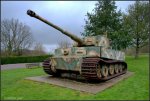
Last edited:
With what the Allies were doing with air power, wouldn't surprise me if they hit it from above.This makes me wonder how the Allies destroyed this beast. Obviously, the ammo inside the turret cooked off and blew the turret off, but how did they get that fire started?
I think you're right. That appears to be a big crater the tank is now sitting in.With what the Allies were doing with air power, wouldn't surprise me if they hit it from above.
Last edited:
- Status
- Not open for further replies.
Latest threads
-
US Army replacing 5.56mm rifle with a 6.8mm for infantry
- Started by Tidewater
- Replies: 6
-
-
Game One of Alabama-Texas A&M Alabama Series Moved to Friday as Part of Doubleheader
- Started by Diamond Tide
- Replies: 0
-
Bama Game Thread: Bama Gymnastics - NCAA Championship Semi-finals (ESPN2 | 4/18 @ 8pm CT)
- Started by BamaNation
- Replies: 32
-
No. 1 Visits Tuscaloosa for Second Straight Week as Alabama Hosts Top-Ranked Texas A&M
- Started by Diamond Tide
- Replies: 0
-

